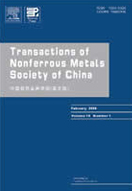Bioleaching and electrochemical property ofmarmatite by Sulfobacillus thermosulfidooxidans
(School of Minerals Processing and Bioengineering, Central South University, Changsha 410083, China)
Abstract: Bioleaching and electrochemical experiments were conducted to evaluate marmatite dissolution in the presence of pure S. thermosulfidooxidans. The effects of particle size, pH controlling and external addition of Fe3+ ions on the zinc extraction were investigated. The results show that in the bioleaching process the best particle size range is 0.043-0.074 mm and adjusting pH regularly to the initial value has a profound effect on obtaining high leaching rate. External addition of Fe3+ ions could accelerate the bioleaching, while the concentration of additional Fe3+ over 2.5 g/L weakens the positive effect, and even hinders the dissolution of marmatite. SEM and XRD analyses of the leaching residues reveal that a product layer composed of elemental sulfur and jarosite is formed on the mineral surface, which results in a low leaching speed at later phase. The results of electrochemical measurements illustrate that additional Fe3+ ions could increase the corrosion current density, which is favorable to zinc extraction. The EIS spectra show that rate-limiting step does not change when Fe3+ions are added.
Key words: marmatite;S. thermosulfidooxidans; bioleaching; jarosite; electrochemical property

